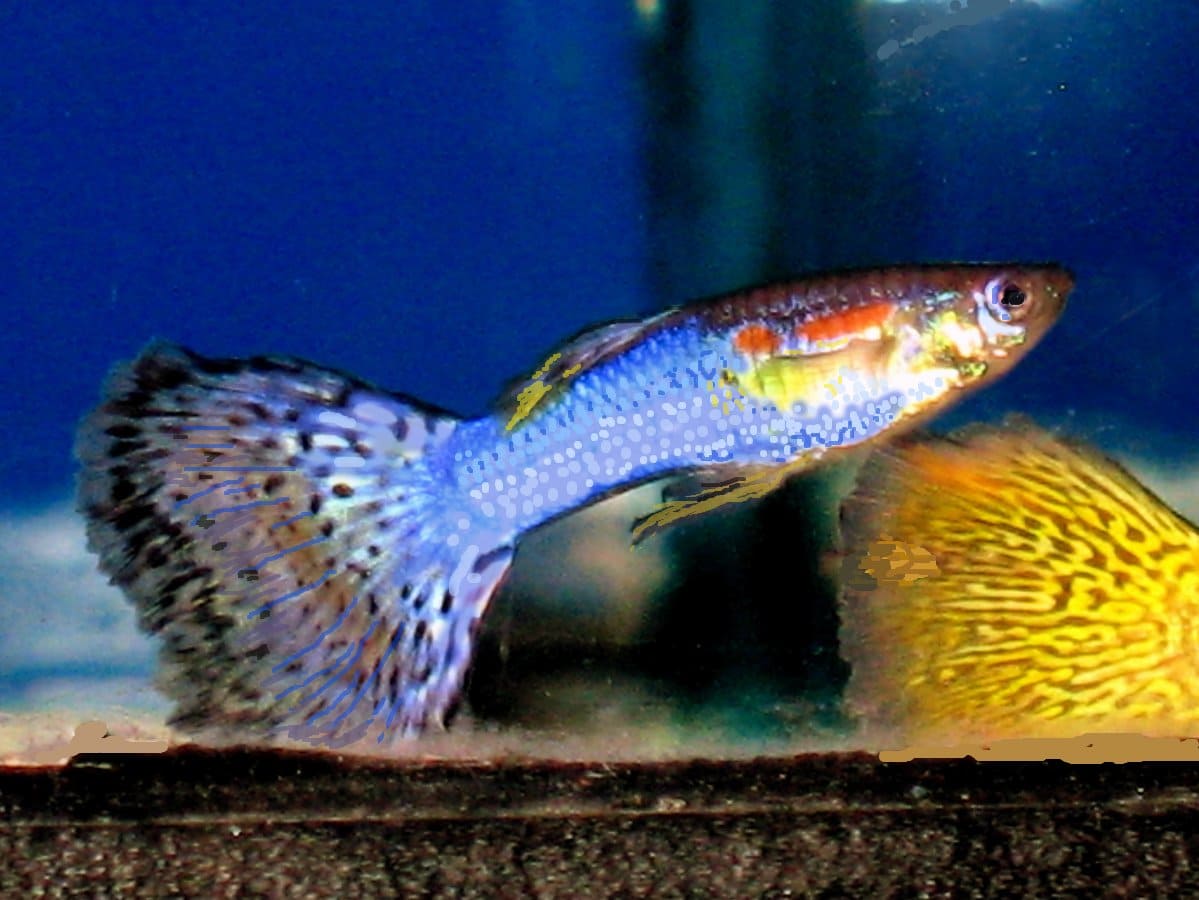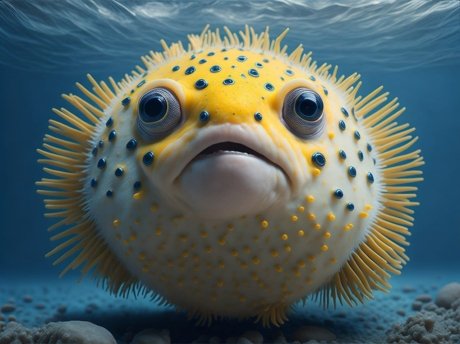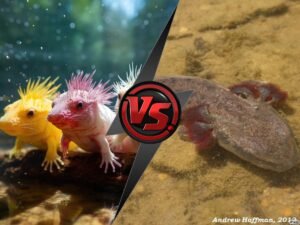Guppy Fish | Price, 10 Rare Species, Care Tips, Colours, Facts, Health
Welcome to the captivating universe of guppy fish! Whether you’re a seasoned aquarium enthusiast or just starting, guppies offer a burst of colour and personality to your tank. This guide unveils the secrets of guppy fish care and breeding. Discover the essentials of their vibrant colours, optimal tank conditions, and expert tips for their well-being. Get ready to embark on a journey that brings the mesmerizing world of guppy fish right to your fingertips.
Guppy Fish
Guppy fish, a tiny aquatic wonder have captured the hearts of fish enthusiasts around the world. From their dazzling array of colours to their playful antics, guppies are a true joy to observe. In this guide, we’ll dive into the captivating world of guppy fish, exploring their origins, care tips, and the mesmerizing varieties that make them a favourite among both novice and experienced fishkeepers.

Varieties of Guppies: One of the most enchanting aspects of guppy fish is their incredible diversity. With a myriad of colour patterns, tail shapes, and fin sizes, each guppy is a unique masterpiece. From the classic Cobra guppy with its striking dorsal fin to the fancy tailed Fantail guppies, there’s a variety to suit every taste. The endless combinations of vibrant colours and intricate patterns are a testament to the beauty of nature’s palette.
Caring for Your Guppy Fish: Creating a suitable habitat for your guppies is key to their well-being. These social creatures thrive in aquariums with ample hiding spots, live plants, and gentle filtration. Maintaining a stable water temperature between 72°F and 82°F (22°C to 28°C) is crucial, along with monitoring water quality through regular testing. A balanced diet of high-quality flake food, supplemented with occasional treats like brine shrimp or daphnia, will keep your guppies healthy and vibrant.

Breeding and Reproduction: Guppy fish are renowned for their reproductive prowess. Their ability to give birth to live fry, rather than laying eggs, is a marvel to witness. Female guppies can store sperm from a single mating to fertilize multiple batches of fry. To successfully breed guppies, providing plenty of hiding spots for the fry is essential, as adult guppies may view them as potential snacks.
Baby Guppy Fish
The journey into the vibrant world of guppy fish begins with the adorable baby guppies. These miniature marvels, with their endearing features and tiny movements, bring a sense of wonder to any aquarium. Watching them navigate their aquatic world and interact with their surroundings is a heartwarming experience that reminds us of the beauty and delicacy of life’s beginnings.

Beautiful Guppy Fish
Guppy fish are nature’s artists, showcasing an awe-inspiring array of colours and patterns that turn aquariums into living canvases. Each guppy variety, from the mesmerizing Butterfly guppy with its delicate wingspan to the elegant Glass Belly guppy with its translucent beauty, offers a unique masterpiece. The vibrant hues, intricate designs, and graceful movements of these fish enrich our underwater landscapes, reminding us of the sheer diversity and artistic brilliance of the natural world.

Pregnant Guppy Fish
The pregnant guppy fish embarks on a remarkable journey as it carries and nurtures developing fry within its belly. This captivating process showcases nature’s incredible design, as female guppies can store sperm and give birth to live fry. Observing the gravid guppy’s expanding belly and the eventual birth of tiny fry is a testament to the wonders of reproduction and the delicate balance of life within an aquarium ecosystem.

Fancy Guppy Fish
Fancy guppy fish embody the epitome of aquatic elegance, with their graceful finnage and vibrant colouration. Whether it’s the striking patterns of the Cobra guppy or the unique tail shapes of the Dumbo guppy, each fancy guppy is a work of art. These fish evoke a sense of sophistication and refinement as they glide through the water, showcasing the meticulous efforts of breeders who have transformed them into living jewels of the aquatic world.

Cobra Guppy Fish
The Cobra guppy fish, named for its distinctive dorsal fin that resembles a cobra’s hood, is a true marvel of nature’s creativity. Its intricate patterns and vibrant colours create an eye-catching display that captivates all who behold it. This variety stands as a testament to the endless surprises that the world of guppy fish holds, reminding us of the intricate beauty that can emerge from the depths of our aquariums.

Rare Dragon Guppy Fish
The rare Dragon guppy fish is a true treasure for those who seek a touch of the exotic in their aquariums. With metallic scales that shimmer like the scales of mythical dragons, this variety adds an aura of enchantment to aquatic setups. Its stunning appearance and intricate patterns evoke the mysteries of legendary creatures, making it a prized addition that fuels our fascination with the realms beneath the waves.
Wild Guppy Fish
Wild guppy fish offer a direct link to the species’ natural habitats and origins. Their subdued colouration and unaltered patterns resonate with a sense of nostalgia for the untamed waters they once inhabited. Keeping wild guppies in our tanks provides a glimpse into the unadulterated beauty of these fish and a reminder of the vast and diverse landscapes from which they originated.

Glass Belly Guppy Fish
The Glass Belly guppy fish introduces an element of intrigue and ethereality to aquariums. With their translucent bodies, these guppies offer a glimpse of their inner workings, creating a captivating visual experience for observers. This variety highlights the delicate intricacies of aquatic life and serves as a mesmerizing reminder of the delicate balance that exists within the aquatic ecosystems we create.
Imported Guppy Fish
Imported guppy fish bring the allure of different regions and breeding techniques to our aquariums. Each variety tells a story of its origin and the journey it undertook to reach our tanks. These guppies introduce a sense of diversity and global exploration, allowing us to connect with the wider world of fishkeeping and appreciate the diverse range of guppy characteristics that enthusiasts worldwide have cultivated.
Aquarium Guppy Fish
Guppy fish are renowned for their adaptability and peaceful nature, making them an ideal choice for aquarium enthusiasts of all levels. From newcomers to seasoned hobbyists, these fish flourish in various tank setups, whether it’s a lush planted environment or a carefully curated community tank. The charm of guppy fish lies not only in their captivating beauty but also in their ability to thrive and bring life to our carefully crafted aquatic worlds
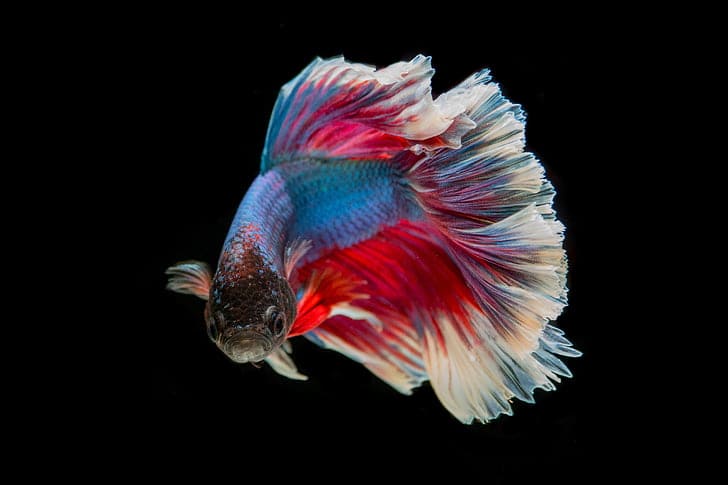
Big Guppy Fish
The big guppy fish commands attention with its impressive size and striking appearance. Larger than the average guppy, these fish possess a commanding presence in aquariums. Their elongated fins and vibrant colours create a visual spectacle that adds grandeur to any tank, making them a centerpiece that captures the gaze and imagination of onlookers.
Koi Fish Guppy
The Koi Fish guppy pays homage to the beauty of Japanese koi with its captivating colour patterns. Resembling the elegant markings of koi carp, this variety introduces a touch of Japanese aesthetics to aquariums. The interplay of colours and the unique scale patterns evoke the serene beauty of koi ponds, allowing enthusiasts to bring a piece of Japanese aquatic culture into their own homes.
Dumbo Guppy Fish
The Dumbo guppy fish is known for its distinctive tail fins that resemble the ears of an elephant. This unique feature adds an endearing charm to the fish’s appearance. With their playful and graceful movements, Dumbo guppies stand out as a whimsical reminder of the marvels that can emerge from selective breeding efforts, demonstrating the artistic potential of nature’s canvas.
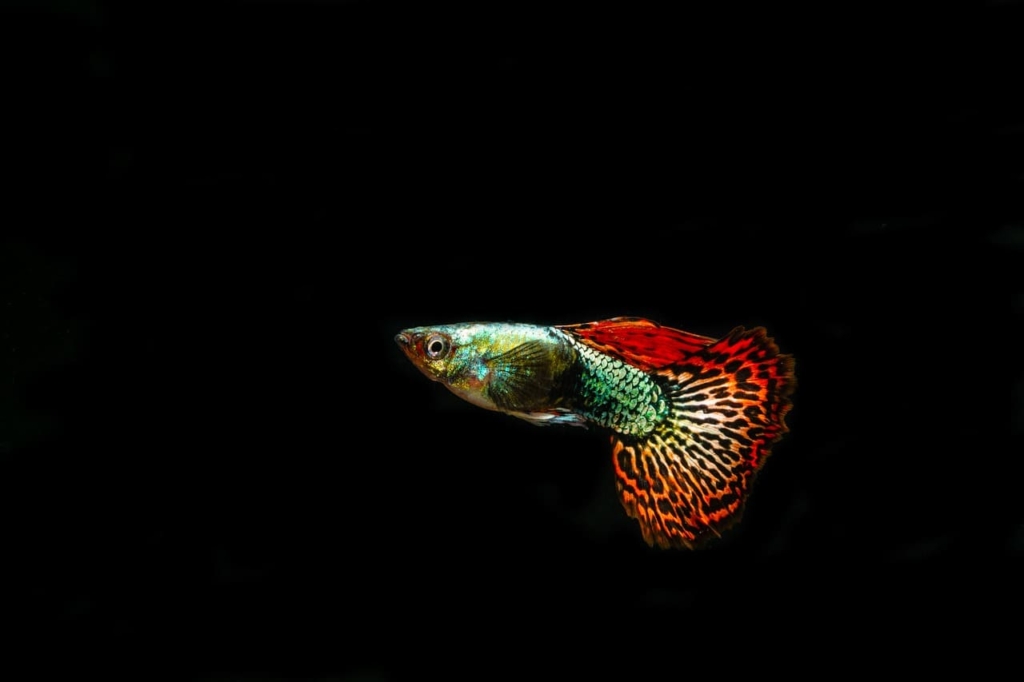
Mud Guppies Fish
The Mud Guppies fish variety stands out with its earthy colouration, evoking a connection to nature’s palette. With shades of brown and green reminiscent of their natural habitats, these guppies offer a rustic and subdued beauty that resonates with those who appreciate a more understated aquatic atmosphere.
Guppy Feeder Fish
Guppy fish extend their charm beyond aesthetics, showcasing practical benefits as well. Guppy feeder fish play a vital role in controlling mosquito larvae in aquatic environments. Their voracious appetite for these pests makes them valuable additions to ponds and tanks, contributing to the natural balance of ecosystems while adding their own visual appeal.
Butterfly Guppy Fish
The Butterfly guppy fish lives up to its name with its distinctively shaped tail that resembles delicate butterfly wings. This variety showcases an enchanting elegance as it glides through the water, its fins creating a dance that adds a touch of ethereal beauty to your tank. The Butterfly guppy stands as a symbol of the intricate and graceful artistry that can be found in the aquatic world.

Indian Guppy Fish
The Indian Guppy fish is a nod to the native diversity of guppy species found in India. These guppies celebrate the rich tapestry of aquatic life that thrives in the region’s water bodies. The Indian Guppy serves as a reminder of the interconnectedness of aquatic ecosystems around the world and the importance of preserving and appreciating the unique aquatic life that each region offers.
Mosquito Fish Vs Guppy
Comparison and differences between Mosquito Fish and Guppy:
| Aspect | Mosquito Fish | Guppy Fish |
|---|---|---|
| Scientific Name | Gambusia affinis | Poecilia reticulata |
| Origin | Native to North and Central America | Native to South America |
| Size | Generally larger, up to 2.5 inches | Smaller, typically around 2 inches |
| Appearance | Behaviour | Less vibrant, often grayish or olive-coloured |
| Behavior | Active surface swimmers, feed on mosquito larvae | Diverse colours, patterns, and fin shapes |
| Tank Environment | Prefer calm waters, suitable for ponds | Prefer planted tanks, adaptable to various setups |
| Reproduction | Give live birth to fry, prolific breeders | Give live birth to fry, popular for breeding |
| Compatibility | Generally peaceful, can coexist with other fish | Peaceful, can be housed with compatible tankmates |
| Predatory Nature | Known to consume mosquito larvae | Not predatory, primarily herbivorous |
| Maintenance Level | Generally easy to care for | Relatively easy to care for |
Guppy Fish Types
Guppy fish, scientifically known as Poecilia reticulata, exhibit an astonishing variety of types that showcase their diverse coluors, patterns, and fin shapes. These types, often referred to as strains or varieties, have been developed through selective breeding. Here are some of the most popular guppy fish types that grace aquariums around the world:

- Cobra Guppies: Named for their distinct dorsal fin resembling a cobra’s hood, these guppies feature vibrant colours and patterns that span their bodies. The elongated dorsal fin adds an elegant touch to their appearance.
- Fan Tail Guppies: With their fan-shaped tails that spread out gracefully, Fan Tail guppies are a sight to behold. Their tails come in various colours and patterns, making them a favourite among guppy enthusiasts.
- Delta Guppies: These guppies have triangular-shaped tails that create a striking profile. They often exhibit a spectrum of colours and patterns, adding a dynamic visual element to aquariums.
- Veil Tail Guppies: Known for their flowing, long tails, Veil Tail guppies are reminiscent of ethereal underwater creatures. Their tails can feature intricate patterns, enhancing their captivating beauty.
- Tuxedo Guppies: Tuxedo guppies showcase a distinctive colour pattern where their bodies are darker in colour, resembling a tuxedo, while their tails and fins exhibit contrasting hues. This creates a sophisticated and eye-catching appearance.
- Lyretail Guppies: With tails that fan out into multiple distinct lobes, Lyretail guppies have an almost artistic quality. Their tails often boast intricate designs and patterns that make them stand out.
- Swordtail Guppies: These guppies are recognized for their elongated lower tail fin, which resembles a sword. The sword can vary in length and may be adorned with vibrant colours or patterns.
- Glass Guppies: Glass guppies possess a translucent quality that gives them a unique and almost ethereal appearance. Their delicate beauty and subtle colours make them a fascinating addition to any aquarium.
- Mosaic Guppies: Mosaic guppies display a patchwork of colours and patterns across their bodies, creating a visually striking and dynamic effect. Each guppy is a living work of art.
- Half Moon Guppies: Named after their tail shape, Half Moon guppies feature tails that spread out to a 180-degree angle, creating a stunning and impressive display.
- Dragon Guppies: These guppies are characterized by their metallic scales and vivid colours, often resembling the scales of a mythical dragon. Their radiant appearance adds a touch of magic to aquariums.
- Metallic Guppies: With shimmering, metallic scales that catch and reflect light, Metallic guppies have a mesmerizing and almost iridescent quality.
Rare Guppy Fish Species
Within the enchanting world of guppy fish, there are several rare and sought-after species that captivate the hearts of aquarium enthusiasts. These unique and often elusive guppies boast features that set them apart from the more common varieties. Here are a few examples of rare guppy fish species that are treasured by collectors and hobbyists:
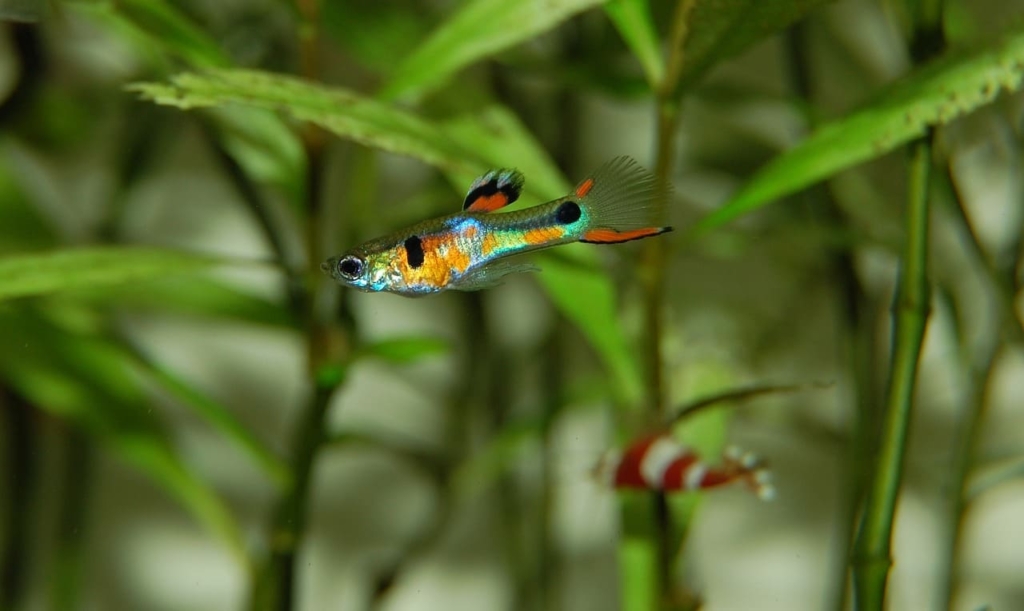
- Snakeskin Guppies: Snakeskin guppies possess a distinctive pattern on their bodies that resembles the intricate scales of a snake. This rare pattern, combined with vibrant colours, creates a captivating and exotic appearance that appeals to guppy aficionados.
- Moscow Guppies: Named after the Russian city, Moscow guppies are known for their deep and rich colours, often combined with a metallic sheen. Their striking appearance, coupled with a refined body shape, makes them highly coveted among guppy enthusiasts.
- Blue Grass Guppies: These guppies feature a stunning blue hue that covers their bodies, reminiscent of the serene beauty of a lush grassy landscape. The iridescent blue colouration is a rarity among guppies, making the Blue Grass variety a true gem.
- Purple Guppies: Purple guppies exhibit a captivating shade of deep purple across their bodies. This unique colouration is relatively rare in the guppy world and adds an air of mystique to any aquarium.
- Albino Guppies: Albino guppies lack the typical pigmentation found in their counterparts, resulting in a pale and translucent appearance. Their rarity and distinct look make them a prized addition to collections.
- Pink Guppies: Pink guppies showcase a delicate and enchanting pink colouration, a departure from the more common guppy colours. Their soft and gentle hue adds a touch of elegance to aquatic setups.
- Black Moscow Guppies: A captivating combination of black and metallic scales characterizes the Black Moscow guppies. Their unique colouration, coupled with a graceful body shape, makes them a sought-after choice for collectors.
- Japanese Blue Guppies: These guppies boast a brilliant blue colour that’s reminiscent of traditional Japanese ceramics. Their stunning appearance pays homage to the artistry of Japan and is a rarity in the guppy world.
- Green Lace Guppies: Green Lace guppies feature intricate green patterns that resemble delicate lacework. Their fine detailing and vibrant colours make them a standout choice for those seeking a distinctive and rare variety.
- Full Platinum Guppies: Full Platinum guppies exhibit a near-complete lack of colouration, resulting in a striking silver or white appearance. Their ethereal and minimalist look adds a touch of elegance to aquariums.
Top 10 Beautiful Guppy Fish
Top 10 beautiful guppy fish varieties with unique descriptions:

- Golden Sunrise Guppy: The Golden Sunrise guppy boasts a radiant blend of warm gold and orange hues that shimmer like the early rays of dawn, creating a captivating and uplifting presence in any tank.
- Emerald Elegance Guppy: With its deep emerald green body adorned with delicate patterns, the Emerald Elegance Guppy brings an air of refinement and natural beauty to your aquarium.
- Sapphire Cascade Guppy: The Sapphire Cascade guppy’s body is adorned with captivating blue scales that resemble a cascade of sapphires, adding a touch of regal allure to your aquatic world.
- Velvet Ribbon Guppy: Characterized by its velvety black body and a ribbon-like tail that features a mix of bold colours, the Velvet Ribbon guppy evokes a sense of graceful drama.
- Aurora Borealis Guppy: The Aurora Borealis Guppy features an enchanting display of iridescent colours that mimic the dancing lights of the Northern Lights, creating a mesmerizing and otherworldly effect.
- Crimson Veil Guppy: The Crimson Veil guppy exhibits a rich crimson body with delicate, flowing fins that create an ethereal and graceful appearance, reminiscent of a delicate veil.
- Moonstone Guppy: With a pearly white body adorned with shimmering patterns, the Moonstone guppy captures the essence of the mystical moonlight, adding an aura of enchantment to your tank.
- Lemon Zest Guppy: The Lemon Zest guppy exudes a vibrant and refreshing yellow colour that’s reminiscent of a zesty lemon, infusing your aquarium with a burst of lively energy.
- Opal Dream Guppy: The Opal Dream guppy showcases a dreamlike play of pastel colours across its body, resembling the shifting hues of an opal gemstone and creating an atmosphere of wonder.
- Scarlet Flame Guppy: With its fiery red body that appears as if it’s aflame, the Scarlet Flame guppy ignites passion and intensity in your tank, making it a captivating centerpiece.
Colorful Guppy Fish
Colourful guppy fish are a true delight for aquarium enthusiasts, offering a vibrant and diverse palette that adds life and energy to aquatic setups. Here are some of the most stunning and colourful guppy fish varieties that will infuse your tank with a burst of hues:
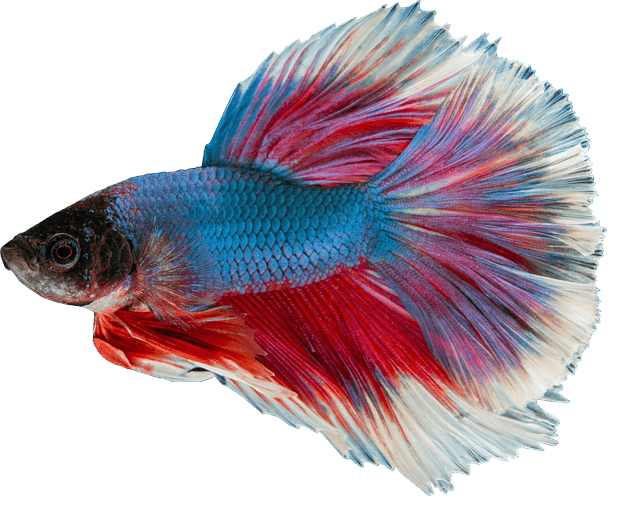
- Rainbow Guppy: Aptly named, the Rainbow guppy displays a brilliant spectrum of colours across its body, resembling a living rainbow in motion. From blues and greens to reds and yellows, these guppies are a lively addition to any tank.
- Neon Guppy: With its neon-bright colouration, the Neon guppy electrifies the underwater scene with intense shades of blue and green that glow under aquarium lighting.
- Sunset Guppy: The Sunset guppy mirrors the warm and captivating colours of a setting sun, showcasing a blend of oranges, pinks, and purples that evoke the tranquil beauty of dusk.
- Electric Blue Guppy: Radiating an intense electric blue hue, this guppy variety captivates the eye and brings a burst of vibrant energy to your aquatic world.
- Golden Flame Guppy: The Golden Flame guppy combines the brilliance of gold with fiery red accents, creating a visual spectacle that resembles a flickering flame.
- Turquoise Delight Guppy: With a body adorned in calming shades of turquoise and aqua, the Turquoise Delight guppy invokes the serenity of clear tropical waters.
- Candy Cane Guppy: Reminiscent of a sweet treat, the Candy Cane guppy showcases a delightful mix of vibrant red and white stripes that create an eye-catching and playful appearance.
- Peacock Guppy: Like the dazzling feathers of a peacock, this guppy variety flaunts a rich blend of iridescent blues and greens that shimmer and change as they move.
- Lavender Haze Guppy: The Lavender Haze guppy envelops itself in a soothing lavender hue, evoking a dreamy and tranquil atmosphere in your tank.
- Mango Tango Guppy: Vibrant oranges and yellows come together in the Mango Tango guppy, exuding a zestful energy reminiscent of tropical fruits.
Guppy Fish Colors
Guppy fish colors are a testament to the dazzling array of pigments that nature has to offer. From vibrant blues to fiery reds, these fish showcase a mesmerizing palette that captures the essence of aquatic beauty. Each color variation tells a unique story, reflecting both the natural world and the artistic touch of selective breeding.
Blue Guppy Fish
Blue guppy fish evoke a sense of tranquility as they glide through the water, their shimmering scales reflecting shades of blue that mirror the depths of serene ocean expanses. Whether it’s the deep and regal hues of the Royal Blue guppy or the vibrant turquoise of the Sapphire Blue guppy, these fish bring an aura of calm and elegance to any aquarium.
Black Guppy Fish
The black guppy fish adds a touch of mystery and contrast to aquatic landscapes. Their dark and velvety coloration sets them apart, creating a captivating visual impact. Whether it’s the Midnight Black guppy or the sleek Black Moscow guppy, these fish embody an enigmatic allure that adds depth to your tank.
Orange Guppy Fish
Orange guppy fish bring a burst of energy and vibrancy to aquariums. Their sunny hues brighten up aquatic spaces, adding a warm and welcoming ambiance. The fiery shades of the Flame Tail guppy or the gentle pastels of the Sunset Orange guppy create a dynamic and cheerful presence that enlivens any underwater world.
Golden Guppy Fish
The golden guppy fish radiates elegance and opulence with its shimmering scales that resemble precious metals. Their gleaming appearance adds a touch of luxury to aquariums, whether it’s the classic Gold Cobra guppy or the enchanting Gold Tuxedo guppy. The golden hues evoke a sense of timeless beauty that captivates the eye.
Grey Guppy Fish
The grey guppy fish presents a subdued and sophisticated charm that’s distinct from the usual vibrant colors. Their neutral tones add a touch of understated elegance to aquariums, providing a subtle backdrop that complements other colorful tankmates. The Silver Guppy and Grey Mosaic guppy are examples of how the understated grace of grey can enhance aquatic aesthetics.
Red Guppy Fish
Red guppy fish are synonymous with fiery passion and undeniable visual impact. Their bold and vibrant hues create a striking presence that commands attention. Whether it’s the deep crimson of the Scarlet Red guppy or the dynamic contrast of the Red Moscow guppy, these fish infuse aquatic setups with a burst of intense energy.
White Guppy Fish
White guppy fish embody purity and elegance with their pristine coloration. Their ethereal appearance evokes a sense of serenity and tranquility, reminiscent of a blank canvas waiting to be adorned with life’s vibrant strokes. Whether it’s the Pearl White guppy or the delicate Snow White guppy, these fish bring a touch of sophistication to any aquarium.
History of Guppy Fish
The history of guppy fish is a captivating tale that dates back to the 19th century. Originally discovered in South America, these fish were later introduced to other parts of the world, leading to their widespread popularity in the realm of aquarium keeping. From their humble beginnings in Trinidad to their journey across continents, the history of guppy fish reflects the enduring fascination that these captivating creatures have inspired over generations.
Appearance of Guppy Fish
The appearance of guppy fish is a remarkable display of nature’s creativity. Their body shapes, fin sizes, and color patterns come together to create a captivating visual spectacle that adds vibrancy to any aquarium. The dorsal fins that resemble intricate tails and the shimmering scales that mimic precious metals are just a few of the elements that contribute to the breathtaking appearance of guppy.

Temperament of Guppy Fish
Guppy fish are renowned for their peaceful temperament, making them ideal companions for various tank setups. Their harmonious interactions with other fish and their playful behavior create a serene and enjoyable atmosphere in aquariums. The guppy’s ability to coexist and interact with its tankmates underscores its gentle and friendly nature.
Behaviour of Guppy Fish
The behavior of guppy fish is a delightful showcase of their inquisitive nature. They are known for their playful antics as they explore their environment, interact with tankmates, and exhibit courtship rituals. Guppies’ active swimming and social interactions reflect their curiosity and contribute to the dynamic and lively ambiance of your aquatic world.
Fish Compatible With Guppies
Fish such as neon tetras, platies, and corydoras are often great companions for guppies due to their similar temperaments and environmental requirements. Ensuring compatibility among fish species fosters a harmonious environment where each species can coexist and thrive.

Will A Betta Fish Kill A Guppy
While betta fish and guppies can coexist in the same tank, caution is advised due to potential compatibility issues. Betta fish are territorial and may display aggression towards guppies, especially if they perceive them as intruders. Introducing proper tank arrangements and providing hiding spots can help mitigate conflicts and create a balanced environment.
Are Guppies Schooling Fish
Guppies are known for their schooling behavior, often grouping together for safety and social interaction. While they may not form tightly-knit schools like some other species, guppies exhibit a preference for swimming in close proximity to their peers. This sense of togetherness enhances their well-being and contributes to their engaging behavior.
What Fish Can Live With Guppies
Guppies’ friendly disposition allows them to share tanks with a variety of fish species. Fish like mollies, swordtails, and danios are often compatible due to their similar requirements and peaceful temperaments. When choosing tankmates, considering factors such as size, temperament, and water conditions helps ensure a harmonious and thriving aquatic community.

Are Guppies Tropical Fish
Guppies are indeed tropical fish, thriving in warmer water temperatures typically found in tropical regions. They flourish in water temperatures between 72-82°F (22-28°C), making them well-suited for aquariums with appropriate heating. Creating a tropical environment ensures the well-being and vibrancy of your guppy fish.
Can A Betta Fish Live With Guppies
The compatibility of betta fish and guppies requires careful consideration of each fish’s temperament and tank setup. While some setups successfully house both species, others may result in aggression. Providing ample space, hiding spots, and monitoring interactions are essential to fostering a peaceful coexistence between bettas and guppies.
Are Guppies Freshwater Fish
Guppies are exclusively freshwater fish, adapted to thrive in aquatic environments devoid of salt. Their natural habitats consist of freshwater streams, ponds, and rivers. Creating a suitable freshwater environment in your aquarium aligns with the natural requirements of guppy fish and ensures their health and well-being.

Guppy Fish Temperature
Maintaining the right temperature is crucial for guppy fish. They thrive in water temperatures between 72-82°F (22-28°C). Keeping the water within this range ensures their physiological well-being, vibrant colors, and active behavior.
Guppy Fish Breeding
Guppy fish breeding is a captivating natural process that involves live birth. Female guppies store sperm and give birth to fry, bypassing the need for external egg fertilization. Breeding enthusiasts carefully select pairs to produce desired traits, contributing to the wide variety of guppy colors, patterns, and fin shapes that exist today.
Guppy Fish Breeding Time
Guppy fish breeding time varies, typically occurring every 20 to 30 days. Female guppies show physical changes when they are gravid, and as their pregnancy progresses, their bellies grow noticeably larger.
How Long Are Guppy Fish Pregnant For
The pregnancy duration of guppy fish is approximately 21 to 30 days. During this period, the female guppy’s abdomen expands as the fry develop within her body. Observing the stages of pregnancy and providing appropriate nutrition and care support the health of both the pregnant female and her developing fry.

Will Rope Fish Eat Guppies
Rope fish are known to exhibit predatory behavior towards smaller fish, including guppies. Due to their elongated bodies and sharp teeth, rope fish may perceive guppies as potential prey. To ensure the safety of your guppies, it’s advisable to avoid housing them in the same tank as rope fish.
Can Guppies Survive In A Fish Bowl
While guppies can survive in a fish bowl, it’s important to note that this setup presents challenges. Fish bowls often lack adequate filtration, space, and proper water parameters. Guppies thrive in environments that mimic their natural habitats, so providing them with a suitable tank equipped with filtration, heating, and ample swimming space is essential for their well-being.
Guppy Fish Price
The price of guppy fish varies based on factors such as color, pattern, and rarity. In the United States, guppies typically range from $2 to $10 USD per fish. In India, guppy fish are more affordable, with prices starting from around INR 50 to 200 per fish.
Guppy Fish Price In United States:
In the United States, guppy fish are commonly available and are considered affordable. Prices can range from $2 to $10 per fish, depending on the variety, coloration, and size.
Guppy Fish Price In United Kingdom:
In the United Kingdom, guppy fish prices are also relatively reasonable. On average, you can expect to pay around £2 to £5 per fish, with certain fancy or rare varieties potentially costing more.
Guppy Fish Price In Australia:
Australia’s guppy fish prices can vary due to the country’s stringent quarantine regulations on imported fish. As a result, locally bred guppies are more prevalent. Prices may range from AUD $5 to $20 per fish.
Guppy Fish Price In Canada:
In Canada, guppy fish prices generally align with those in the United States. Prices can vary based on location, availability, and the rarity of the variety. You can expect to pay anywhere from CAD $2 to $10 for a guppy fish.
Guppy Fish Price In Singapore:
Singapore’s tropical climate makes it a suitable environment for guppy breeding. Prices for guppy fish in Singapore can range from SGD $2 to $15 per fish.
Guppy Fish Price In Brazil:
In Brazil, guppy fish prices can vary depending on the region and the availability of specific strains. Prices might range from BRL 5 to 30 per fish.
Guppy Fish Price In Japan:
Japan has a thriving aquarium hobbyist community, leading to a wide variety of guppy strains. Prices for guppy fish in Japan can be higher, starting from around JPY 500 to 1,500 per fish.
Guppy Fish Price In India
Guppy fish prices in India can vary based on location, availability, and strain. On average, basic guppy varieties start from around INR 20 to 50 per fish, while premium or unique strains may cost between INR 100 to 300 or higher.
Guppy Fish Price In Kerala
In the state of Kerala, India, guppy fish prices follow the country’s trends. Prices generally range from INR 20 to 50 for standard varieties, with premium strains potentially costing more.
Guppy Fish Price In Bangalore
Guppy fish prices in Bangalore, India, align with the national market. Basic guppy varieties can be found for INR 20 to 50 per fish, while specialized strains or premium selections may have higher price points.
Guppy Fish Price In Kolkata
Kolkata, India, offers a diverse range of guppy fish options. Prices generally range from INR 20 to 50 for common guppy varieties. Unique or selectively bred strains might be priced higher, offering enthusiasts a selection of guppies that reflect their preferences.
Guppy Fish Price In Mumbai
In Mumbai, India, guppy fish prices are influenced by the national market trends. Prices typically start from INR 20 to 50 for standard strains, while more distinctive or premium guppy varieties may command higher prices.
Guppy Fish Food Price
The price of guppy fish food varies based on brand, quality, and quantity. A typical container of guppy fish flakes or pellets can range from $5 to $15 USD. Specialty foods designed to enhance coloration or support specific needs may be priced higher.
Red Guppy Fish Price
Red guppy fish prices depend on the strain and intensity of coloration. In the United States, prices can range from $2 to $10 USD per fish. In India, red guppy fish may start around INR 50 to 100 for basic varieties.
Guppy Fish Prices In Major Indian and USA Cities
Guppy Fish Average Prices In Major Indian and USA Cities:
| City | Guppy Fish Price |
|---|---|
| Guppy Fish Price In Mumbai | 20 – 50₹ |
| Guppy Fish Price In Delhi | 20 – 50₹ |
| Guppy Fish Price In Bangalore | 20 – 50₹ |
| Guppy Fish Price In Kolkata | 20 – 50₹ |
| Guppy Fish Price In Chennai | 20 – 50₹ |
| Guppy Fish Price In Hyderabad | 20 – 50₹ |
| Guppy Fish Price In Pune | 20 – 50₹ |
| Guppy Fish Price In Ahmedabad | 20 – 50₹ |
| Guppy Fish Price In Jaipur | 20 – 50₹ |
| Guppy Fish Price In Surat | 20 – 50₹ |
| Guppy Fish Price In New York | $2 – $10 |
| Guppy Fish Price In Los Angeles | $2 – $10 |
| Guppy Fish Price In Chicago | $2 – $10 |
| Guppy Fish Price In Houston | $2 – $10 |
| Guppy Fish Price In Phoenix | $2 – $10 |
| Guppy Fish Price In Philadelphia | $2 – $10 |
| Guppy Fish Price In San Francisco | $2 – $10 |
| Guppy Fish Price In Boston | $2 – $10 |
| Guppy Fish Price In Dallas | $2 – $10 |
| Guppy Fish Price In Washington D.C | $2 – $10 |
Factors that Affect the Price of Guppy Fish
The price of guppy can be influenced by a variety of factors that reflect their uniqueness and demand within the market. Some key factors include:
- Strain and Genetics: Selectively bred strains with distinct characteristics, such as larger fins or unique body shapes, often command higher prices due to the specialized breeding efforts involved.
- Age and Size: The age and size of the guppy can affect their price. Mature or larger fish might be priced higher, especially if they are ready for breeding or display.
- Quality: Guppy with strong and healthy genetics, clear colouration, and well-developed fins are often valued more by enthusiasts, leading to higher prices.
- Rarity: Rare or unique guppy varieties that are less commonly found in the market tend to have higher price tags due to their exclusivity.
Monthly Maintenance Cost of Guppy Fish:
The monthly maintenance cost of guppy depends on several factors that contribute to their well-being and the overall health of their environment:
- Aquarium Size: The size of the aquarium affects the cost of equipment, water changes, and maintenance supplies.
- Water Parameters: Maintaining proper water temperature, pH levels, and water quality requires regular testing and adjustments, which can incur costs.
- Filtration System: A quality filtration system helps keep the water clean and clear, but it may require occasional replacement of filter media.
- Heating and Lighting: Keeping the water temperature stable and providing adequate lighting contribute to the overall health of guppy.
- Food: Guppy fish require a varied and balanced diet. The cost of high-quality fish food should be factored into the monthly maintenance budget.
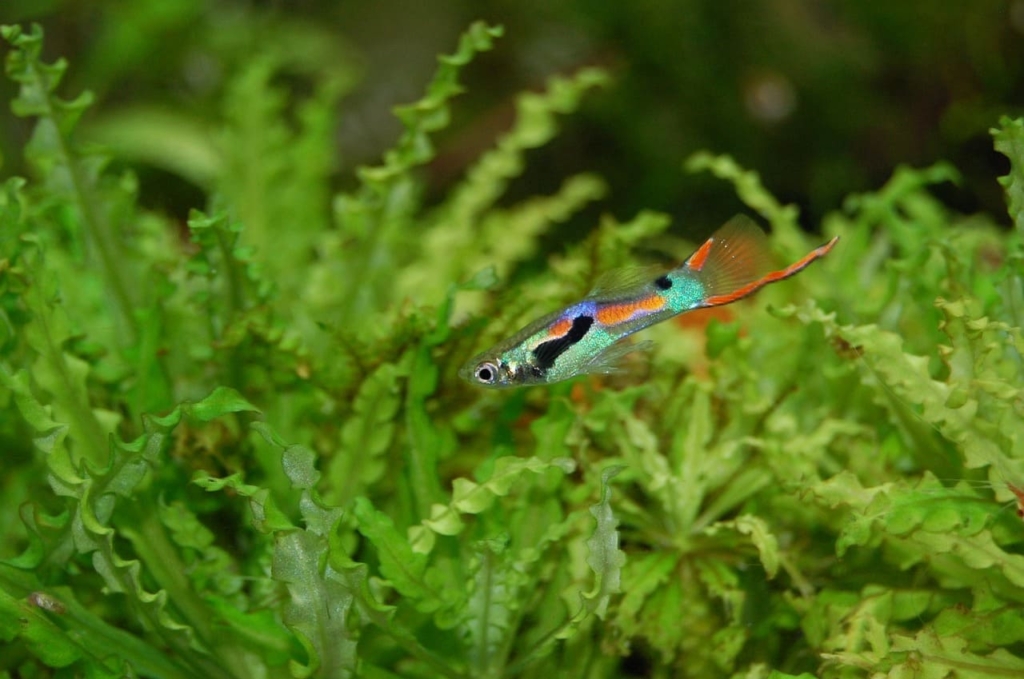
Facts about Guppy Fish
Facts about Guppy Fish: Exploring the World of Colorful Aquatic Wonders:
- Livebearing Marvels: Guppy fish (Poecilia reticulata) are known for their livebearing nature, meaning they give birth to fully-formed fry rather than laying eggs.
- Diverse Color Palette: Guppies boast a remarkable array of colours and patterns, making them a favourite among fish enthusiasts. Their genetics can lead to an astonishing variety of colour combinations, from metallic gold to deep blues, reds, and even vibrant greens.
- Selective Breeding Mastery: Over generations, selective breeding efforts have led to the development of specialized guppy strains with distinct features.
- Peaceful Community Members: Guppies are generally peaceful and social fish, making them ideal inhabitants for community aquariums. Their gentle temperament allows them to coexist with a variety of other fish species, enhancing the overall harmony of the tank.
- Natural Pest Controllers: In addition to their aesthetic appeal, guppies serve a practical purpose as natural mosquito larvae predators. Their appetite for mosquito larvae makes them valuable in controlling mosquito populations in outdoor water bodies.
- Colour Changes as Social Signals: Male guppies exhibit colour changes and vibrant displays as part of their courtship behaviour.
- Short Lifespan: Guppies have a relatively short lifespan compared to some other fish species. On average, they live for around 2 to 3 years, although optimal care can extend their lifespan by a few additional months.
- Females Rule in Numbers: In most guppy populations, females outnumber males. This disparity is due to the high reproductive potential of females and their ability to store sperm for multiple pregnancies.
- Wide Geographic Range: Guppy fish are native to northeastern South America, primarily found in countries like Venezuela, Guyana, and Trinidad.
- Mosaic of Behavior: Guppies display a wide range of behaviours, from playful swimming to exploratory activities.
Pros and Cons of Guppy Fish
Some common pros and cons of keeping guppy fish in an aquarium:
| Pros of Guppy Fish | Cons of Guppy Fish |
|---|---|
| Guppies come in a wide variety of vibrant colours and patterns, enhancing the visual appeal of aquariums. | Guppy fish have a relatively short lifespan compared to some other aquarium fish species, typically living around 2 to 3 years. |
| Guppies are prolific breeders, making them an ideal choice for beginners interested in breeding fish. | Due to their high reproductive rate, guppies can quickly overpopulate a tank if not managed carefully. |
| Guppies are generally peaceful and can coexist well with a variety of other fish species in community tanks. | Guppy fish can be susceptible to common aquarium diseases, especially if water quality and conditions are not properly maintained. |
| Guppies are effective mosquito larvae predators, helping to control mosquito populations in outdoor water bodies. | In densely populated tanks, male guppies might become territorial and exhibit aggression, particularly during mating competitions. |
| Guppies are active swimmers and exhibit playful behaviors, creating an engaging and dynamic aquarium environment. | Guppies are known jumpers, so a secure tank cover is necessary to prevent escapes. |
Pictures Of Guppy Fish
24 Beautiful Pictures Of Guppy Fishes:

















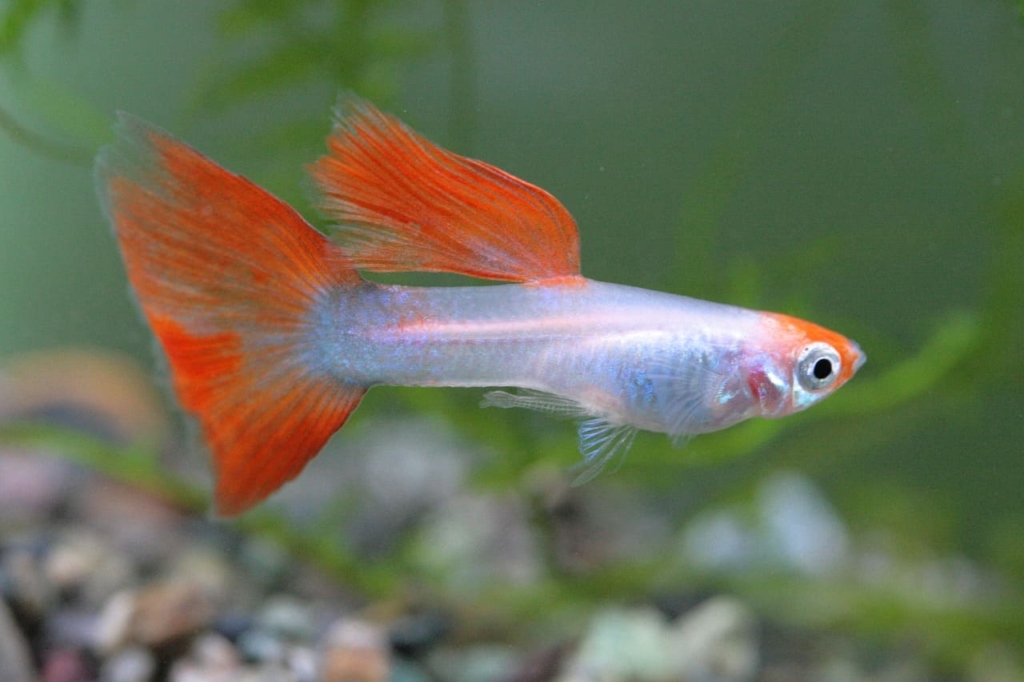
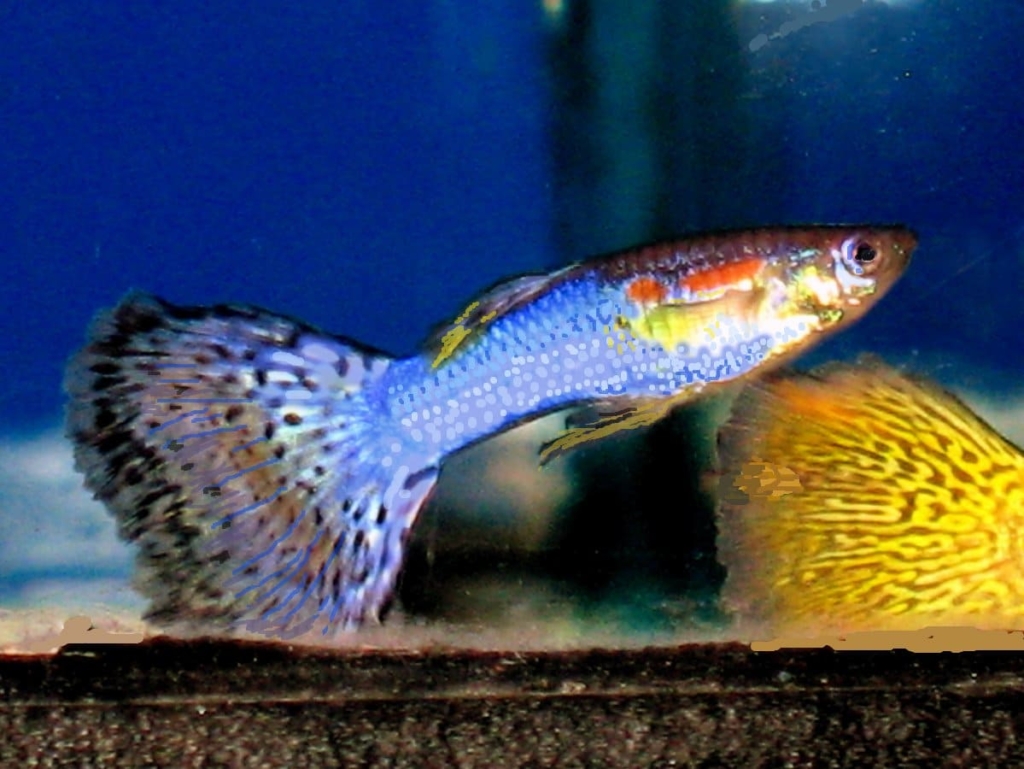




5 Guppy Fish Tank Ideas
Designing a captivating guppy fish tank goes beyond providing a suitable habitat; it’s an opportunity to create a visually stunning and enriching environment for both your guppies and yourself. Here are some innovative guppy fish tank ideas to inspire your aquatic masterpiece:
1. Natural Aquascape: Embrace the natural beauty of underwater landscapes with live plants, driftwood, and rock formations. Recreate a lush ecosystem with aquatic vegetation like Java ferns, anubias, and mosses, while using natural elements to mimic riverbeds and serene water bodies.
2. Color-Themed Tanks: Explore the magical world of colour by designing your tank around a specific colour theme. From serene blues to vibrant reds, select decorations, substrate, and fish that complement your chosen palette, creating a visually harmonious and captivating display.
3. Biotope Setup: Transport your guppies to their native habitat by replicating a biotope tank. Research their natural environments, be it tropical rivers or rainforest streams, and recreate the unique flora, fauna, and water conditions they would encounter in the wild.
4. Nano Aquariums: For limited spaces, nano aquariums offer a compact yet captivating setup. Utilize small tanks, creative backgrounds, and nano-friendly decorations to craft a miniature underwater world that’s charming and space-efficient.
5. Planted Jungle: Transform your tank into a lush underwater jungle with an abundance of densely planted areas. Combine tall plants, floating plants, and submerged driftwood to create a captivating ecosystem that your guppies can explore and seek refuge within.
Guppy Fish Care
Guppy care involves a balanced setup for physical, social, and dietary needs. Optimal conditions ensure colorful companions thrive:
- Aquarium Setup:
- Tank Size: 10-gallon for small groups.
- Filtration: Quality filter for clarity.
- Substrate: Fine gravel or sand.
- Decorations: Plants, caves for hiding.
- Water Conditions:
- Temperature: 72-82°F (22-28°C).
- pH Level: 6.8 to 7.8.
- Water Quality: Regular 25% changes, proper filtration.
- Tank Mates:
- Peaceful Friends: Neon tetras, platies, corydoras.
- Avoid Aggression: No aggressors.
- Nutrition:
- Varied Diet: Flake, pellet, live/frozen.
- Regular Feeding: Small amounts 2-3x daily.
- Healthcare:
- Quarantine: New fish isolation.
- Observation: Watch for illness, stress.
- Medication: Expert-guided treatment.
- Breeding:
- Separate Fry: Protect newborns.
- Fry Food: Specialized options.
How Big Do Guppy Fish Get
Guppy fish, also known as Poecilia reticulata, are small-sized freshwater fish that usually reach a length of around 1.5 to 2.5 inches. Their size makes them perfect for various aquarium setups, from community tanks to smaller bowls.
Guppy Fish Size
The average size of guppy fish can be around 1.5 to 2.5 inches, with males being slightly smaller than females. However, selective breeding efforts have led to the development of unique strains with varying fin lengths and body sizes, showcasing the diversity within this vibrant fish species.
Guppy Fish Eggs
Guppies are livebearers, meaning they give birth to live fry instead of laying eggs. Once pregnant, female guppies carry developing fry in their bodies until they are ready to be released. This fascinating reproductive strategy sets guppies apart from many other fish species.
Guppy Fish Tank
Creating an ideal guppy fish tank involves providing a balanced environment. A tank of around 10 gallons can comfortably accommodate a small group of guppies. Incorporate suitable decorations, plants, and hiding spots to mimic their natural habitat and reduce stress.
Guppy Fish Face
While guppies don’t exactly have facial expressions, their colourful patterns and vibrant hues are what catch the eye. From metallic golds to deep blues and fiery reds, their distinctive markings are like unique signatures that showcase their individuality.

Guppy Fish Bowl
Guppy fish bowls can be considered, but it’s essential to note that these fish thrive best in a well-filtered aquarium with stable water conditions. If you choose a bowl, ensure it’s appropriately sized, and regular maintenance is a must to keep your guppies healthy.
Guppy Fish Growth Chart
Guppy Fish Growth Chart with age and months:
| Age (Months) | Length (Inches) |
|---|---|
| 1 Month | 0.5 – 0.75 Inches |
| 2 Month | 1.0 – 1.25 Inches |
| 3 Month | 1.5 – 2.0 Inches |
| 4 Month | 2.0 – 2.5 Inches |
| 5 Month | 2.5 – 3.0 Inches |
| 6 Month | 3.0 – 3.5 Inches |
Guppy Fish Sleeping
Guppy fish don’t have eyelids, so they don’t sleep in the same way humans do. However, they do have periods of rest where they become less active. Providing a quiet and dim environment during these times is important for their overall well-being.
Pregnant Guppy Fish Stages
The pregnancy journey of a guppy fish unfolds through several stages:
- Early Pregnancy: Internal embryo development begins.
- Gravid Spot: Visible dark spot near the abdomen.
- Swollen Abdomen: Abdomen grows as fry develop.
- Darkened Gravid Spot: Spot intensifies due to developing eyes.
- Restlessness: Increased activity and seeking hiding spots.
- Pre-Birthing Behavior: Erratic swimming and feeding patterns.
- Birthing: Quick release of live fry.
- Afterbirth Consuming: Female consumes afterbirth.
- Post-Birthing Behavior: Females recover, regain activity.
Guppies Fish Farm
Guppy fish farming involves:
- Breeding Setup: Creating controlled environments to regulate reproduction.
- Selective Breeding: Breeding for specific traits like color or fin shape.
- Health Monitoring: Regular checks to prevent diseases.
- Fry Care: Nurturing young guppies until they’re strong.
- Quality Assurance: Ensuring the fish are healthy.
- Market Distribution: Supplying guppies to aquarium enthusiasts.
- Genetic Diversity: Maintaining diverse strains for overall health.
Guppy fish farms are vital in offering diverse and healthy guppies for aquariums.
Health Issues of Guppy Fish
Caring for your guppy fish (Poecilia reticulata) involves being alert to potential health issues:
- Fin Rot: Frayed fins due to poor water quality or bacterial infections. Maintain clean water and use antibacterial treatments.
- Ich (White Spot Disease): Small white spots caused by parasites. Quarantine new fish, raise tank temperature, and treat accordingly.
- Swim Bladder Disorder: Balance issues from overfeeding or infections. Feed a balanced diet, avoid overfeeding, and ensure proper water conditions.
- Parasites: External and internal parasites causing scratching and lethargy. Quarantine, maintain hygiene, and use anti-parasitic treatments.
- Dropsy: Bloating and raised scales due to bacterial infections. Isolate, improve water quality, and treat with antibiotics.
- Mouth Fungus (Columnaris): White lesions around mouth and fins. Maintain clean water, reduce stress, and use antibiotics.
- Fungus Infections: Cotton-like growths due to damaged skin or stress. Isolate, improve water quality, and use antifungal treatments.
- Tail and Fin Biting: Stress-related nipping. Provide hiding spots and suitable tank mates.
- Guppy Disease (Velvet Disease): Rusty appearance caused by parasites. Quarantine, maintain water quality, and treat.
- External Injuries: Injuries from rough handling or aggression. Isolate, provide safe tank decor, and address aggression.
Guppy Fish Lifespan
The lifespan of guppy fish (Poecilia reticulata) typically ranges from 2 to 3 years. However, with attentive care, a balanced diet, proper water conditions, and a stress-free environment, guppies can occasionally exceed this average lifespan.
Guppy Fish Food
Best Guppy Fish Food: A Variety for Optimal Nutrition:
| Food Type | Description |
|---|---|
| Flakes | Balanced nutrition in convenient flakes form, rich in vitamins, minerals, and essential proteins. |
| Pellets | Sinkable pellets for varied diet, available in different sizes and formulations. |
| Live/Frozen Food | Nutrient-rich options like brine shrimp, daphnia, and bloodworms for added dietary diversity. |
| Vegetables | Blanched veggies like spinach, zucchini, and peas provide essential fiber and nutrients. |
Guppy Fish Food Flakes
Best Guppy Fish Food Flakes: A Staple Diet for Guppies:
| Flake Type | Description |
|---|---|
| Tropical Flakes | Specially formulated for tropical fish like guppies, these flakes offer a balanced diet. |
| Color-Enhancing | Flakes enriched with pigments that bring out vibrant colors in guppies. |
| Spirulina Flakes | Flakes containing spirulina algae, ideal for herbivorous guppies and promoting health. |
| High-Protein Flakes | Protein-packed flakes to support growth and energy needs, suitable for young guppies. |
Baby Guppy Fish Food
Best Baby Guppy Fish Food: Nurturing Early Stages:
| Food Type | Description |
|---|---|
| Baby Brine Shrimp | Nutrient-rich live or frozen treat, suitable for newly hatched fry due to their tiny size. |
| Micro Pellets | Tiny pellets designed for young fry, offering essential nutrition as they grow. |
| Crushed Flakes | Crushing regular flakes into smaller pieces provides a suitable size for baby guppies. |
| Infusoria | A homemade option: tiny aquatic organisms growing in water rich with nutrients, ideal for fry. |
Guppy Fish Names
Popular Guppy Fish Names: Adding Personality to Your Aquarium:
| Name Type | Description |
|---|---|
| Color-Inspired | Names based on your guppy’s colors, like “Ruby” for a red guppy or “Sapphire” for a blue one. |
| Personality-Based | Naming after observed behaviors, like “Splash” for an active guppy or “Bubbles” for a playful one. |
| Historical Names | Choosing names inspired by history or mythology, such as “Cleopatra” or “Neptune.” |
| Unique Names | Inventive names that reflect your guppy’s distinct features, like “Finley” for elaborate fins. |
Guppy Fish Video
Conclusion:
In conclusion, understanding the dietary needs of guppy fish is essential for their overall health and vibrancy. Whether you opt for flakes, pellets, live/frozen food, or even vegetables, providing a balanced and varied diet ensures their optimal nutrition. Likewise, naming your guppies adds a touch of individuality to your aquarium, whether inspired by their colors, behaviors, history, or uniqueness. By catering to their nutritional needs and embracing their distinct personalities, you can create a thriving and personalized aquatic world for your guppy companions.
Frequently Asked Questions on Guppy Fish:
-
How many guppies can I keep in a 10-gallon tank?
A 10-gallon tank can comfortably house around 5 to 7 guppies, ensuring ample space for swimming and growth.
-
What’s the lifespan of a guppy fish?
On average, guppy fish live for about 2 to 3 years. Providing proper care and a suitable environment can extend their lifespan.
-
Can I keep male and female guppies together?
Yes, but it’s advisable to have more females than males to prevent excessive mating stress. A ratio of 2-3 females per male is recommended.
-
How often should I feed my guppies?
Feed adult guppies 2-3 times a day in small portions, while baby guppies may need more frequent feedings. Observe them to gauge their appetite.
-
What’s the ideal water temperature for guppies?
Guppies thrive in temperatures between 72°F and 82°F (22°C – 28°C). Consistent temperature is crucial to their well-being.
-
How do I introduce new guppies to my tank?
Quarantine new guppies for a couple of weeks to prevent introducing diseases. Slowly acclimate them to your tank’s water temperature before releasing them.
-
Can guppies live with other fish species?
Yes, guppies are generally peaceful and can coexist with other peaceful community fish like tetras, mollies, and swordtails.
-
Do guppies need a heater in their tank?
Yes, a heater is recommended to maintain a stable temperature within the suitable range for guppies.
-
Why are my guppy’s fins clamped?
Clamped fins can indicate stress, poor water conditions, or the presence of disease. Check water parameters and observe for other symptoms.
-
How do I know if my guppy is pregnant?
A pregnant guppy will have a dark spot near her back fin (gravid spot) that darkens as she nears giving birth. She might also appear rounder.
-
Can I breed guppies in a community tank?
Yes, guppies can breed in a community tank, but it’s recommended to have a separate breeding tank to protect the fry.
-
Do guppies jump out of the tank?
Yes, guppies can jump if they feel stressed or the tank conditions are unsuitable. Make sure your tank has a secure lid.
-
How often should I clean my guppy’s tank?
Regular maintenance is key. Perform partial water changes of about 20-30% every 1-2 weeks and clean the substrate as needed.
-
Can I keep guppies in a bowl?
While possible, it’s not ideal. Guppies thrive in well-filtered aquariums with stable conditions. Bowls lack proper space and filtration.
Recommended –
Dove Birds | History, 4 Types, Pigeons, Price, Facts, Care Tips, Health
Belgian Malinois Dog | Breed Profile, Price, 15 Facts, Care Tips, Health

























